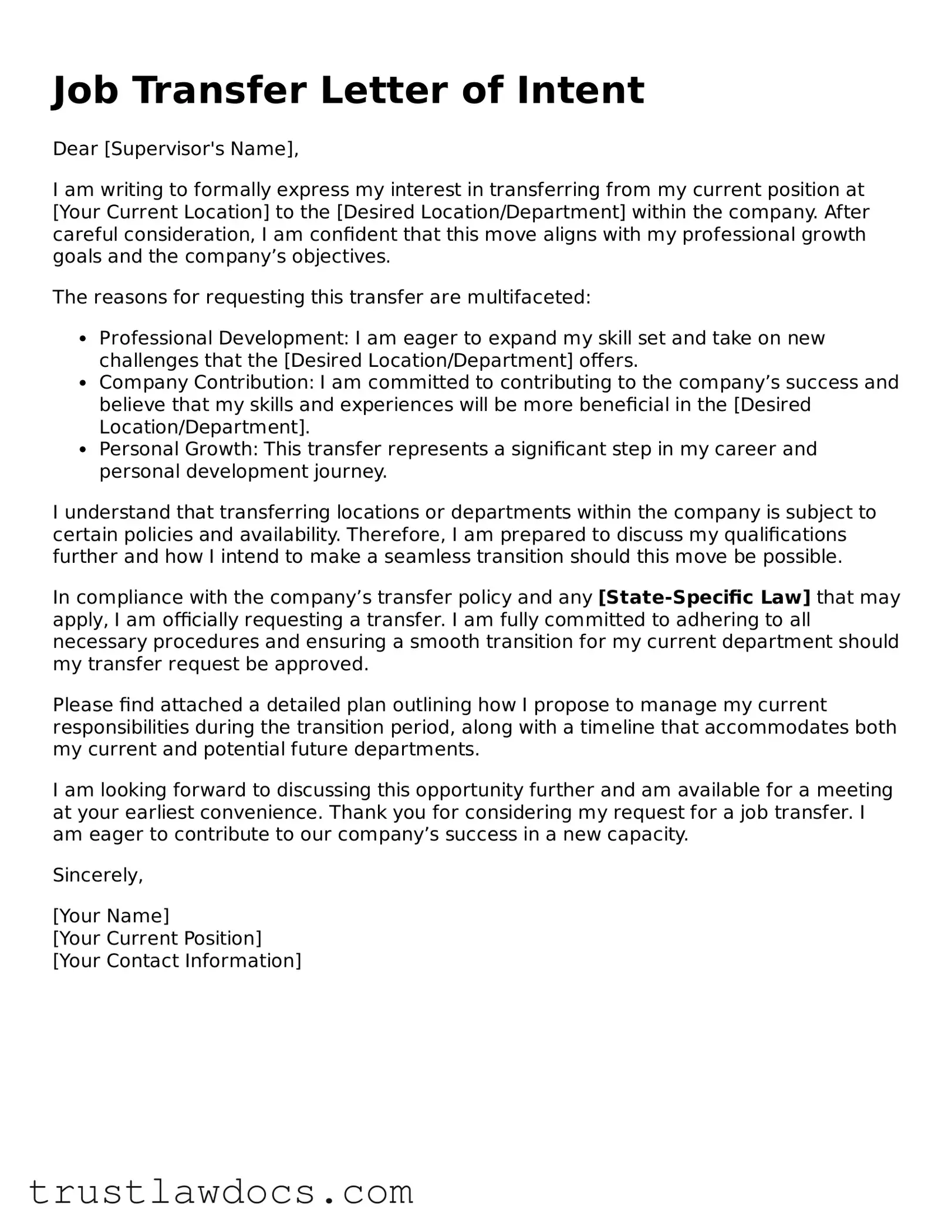A Job Transfer Request Letter is closely related to a Job Transfer Letter of Intent, both serving the purpose of expressing an employee's desire to move from one position or location to another within the same company. The key difference is that the request letter could be less formal, simply seeking a conversation about the possibility of a transfer, while the letter of intent strongly states the employee's intention to move, often including reasons and qualifications.
The Promotion Request Letter shares a similarity with the Job Transfer Letter of Intent as it's an employee-initiated document aimed at changing their status within an organization. Instead of seeking a lateral move as with a transfer, this letter seeks upward movement, advocating for the employee's elevation in rank, responsibilities, and salary. It puts forth an argument as to why the employee deserves the promotion, mirroring the intentionality of a transfer letter but with a focus on advancement rather than relocation.
An Internal Job Application Cover Letter is another document that parallels the Job Transfer Letter of Intent, albeit for a slightly different purpose. This letter is used when applying for a different position within the same organization. It emphasizes the applicant's interest in the new position and their qualifications relevant to it. Like the transfer letter of intent, it communicates the employee’s desire to shift roles within the company but is specifically geared toward a known vacancy.
The Resignation Letter, while seeming to be the antithesis of the Job Transfer Letter of Intent, can be similar in its underlying purpose. Both documents mark a significant change in the employee's career with the company. While the resignation letter signifies an intention to leave the company, it sometimes opens the door for negotiation, potentially leading to a transfer offer as a counteraction by the employer to retain the employee.
Relocation Request Letters echo the Job Transfer Letter of Intent when the desired transfer involves moving to a different geographic location within the same company. These letters often detail the reasons for relocation, such as personal circumstances or a strategic career move, and highlight the employee’s willingness to remain with the company despite the geographic shift, emphasizing a commitment to their employer that mirrors the intent to transfer.
A Performance Evaluation Report can indirectly relate to the process surrounding a Job Transfer Letter of Intent. While not a request or intent document itself, it provides a critical backdrop for the employee's transfer request. A positive evaluation can bolster the employee’s case for a transfer, demonstrating their value to the company and readiness for a new role or location, thereby supporting the claims made in the letter of intent.
Letters of Recommendation, often required for external job applications, can also play a role in an internal transfer process, similar to a Job Transfer Letter of Intent. These letters, written by supervisors, colleagues, or other professional contacts, endorse the employee's skills, work ethic, and achievements. Although they're more frequently used for opportunities outside the current workplace, they can also lend credibility to an internal transfer request by highlighting the employee's strengths and contributions.
A Career Development Plan, while broader in scope, shares a goal with the Job Transfer Letter of Intent: advocating for the employee's growth within the company. This formal plan outlines the steps necessary for the employee to reach their long-term career objectives, including potential transfers. By presenting a mapped-out vision for one's career trajectory, it implicitly includes the intention to seek roles that align with this growth, similar in spirit to a transfer request.
Lastly, an Employee Satisfaction Survey, though not directly related to a transfer, can provide insights that lead to the creation of a Job Transfer Letter of Intent. Surveys might reveal an employee’s dissatisfaction with their current role or location, or a desire for new challenges. The outcomes of these surveys can prompt an employee to formally request a transfer, using the survey results as a basis to argue for how a change in position or location would increase their job satisfaction and productivity.
